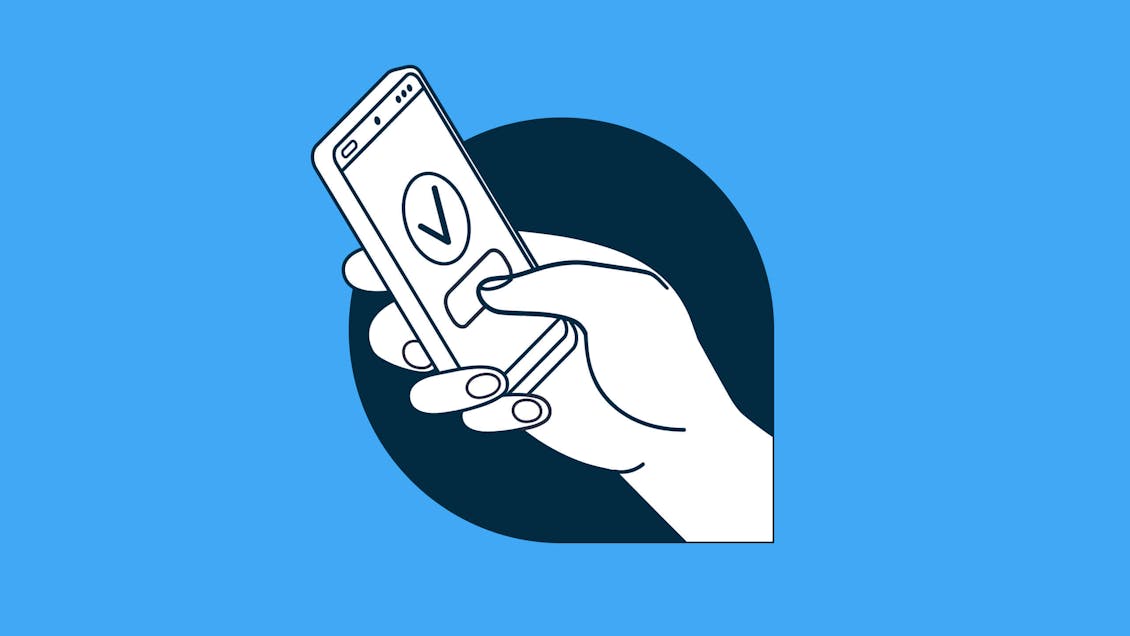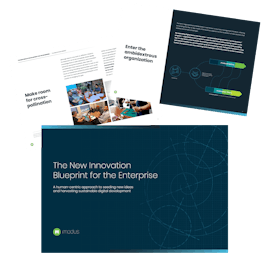How to create a human-centered digital experience

What is human-centered design, and why is it crucial for digital transformation?
B2B. B2C. UX. We’ve heard these acronyms bandied about, but what do they really mean? Yes, they’re short for “business-to-business,” “business-to-consumer,” and “user experience.” But if you think these terms used to describe interactions feel robotic and inadequate, congratulations — you’ve got a pulse.
The truth is, today’s customers want and expect their digital experiences to feel “human-to-human” — organic and intuitive. People buy products and services made by other people — all of whom are infinitely more complex, emotional, and vulnerable than the word “user” can entail. And no matter your industry, your customers are not buying a product or service to “use” it, rather, they are motivated by a human desire — to realize a hope, solve a problem, or allay a fear, for example.
So, how can organizations ensure their digital experiences are relevant to people? In simple terms, UX becomes HX (human experience). This guide will walk you through some of the human-centered design strategies that you can apply to your product and service development process from conception to implementation. Keep reading to discover:
- What is human-centered design?
- The importance of prioritizing human needs in digital design
- Real-world examples of human-centered design
- Human-centered design is all about asking the right people the right questions
- How to integrate user feedback loops and share insights across the organization
- How is human-centered design different from design thinking?

Image: Diagram of the design sprint process, showing a cycle that starts with Research, Ideate, Prototype, Design, Build, and Optimize.
What is human-centered design?
Human-centered design is a process of understanding the feelings, emotions, and situational context of the people who interact with a product or service in order to create an experience that appeals to them.
When developing digital experiences or products, human-centered design typically involves a phased approach:
- Empathize with users’ challenges and needs through a rapid discovery process. Tasks may include qualitative interviews (such as open-ended questions) and quantitative research (such as surveys, polls, heatmaps, A/B tests, and traffic data). Questions for the design team at this stage include: Who are we building for and why? What do we want them to achieve?
- Synthesize discovery findings to define the end-user’s specific problem to be solved. Questions for the design team at this stage include: How did our findings challenge our assumptions about our user base?
- Ideate tailored and innovative solutions that will impact the end-user community. Generate as many ideas as possible from a diverse team. Questions for the design team at this stage include: What should the user experience look and feel like? Where in the user journey would our potential solution be applied?
- Prototype solutions to quickly understand whether the solution is viable or not. For the prototyping stage, start with the most simple, achievable Minimum Lovable Product (MLP) and bring it to select target audiences for feedback and analysis. The prototype could be a clickable mockup, a video, or a visual sketch of the concept — anything that can be created with minimal time and resources to illustrate your core idea. Questions for the design team at this stage include: Does this solution solve the problem? Is the product or solution usable for people?
- Continuously test and iterate based on user feedback. Decide how many rounds of iteration and testing your prototype will have before continuing to the next step: handoff to creative and development, repeat, or shelve.
These are the key steps for teams to focus on to deliver seamless and engaging interactions that delight users and fulfill their needs at every stage of their journey.
The importance of prioritizing human needs in digital design
Why put people at the center of the design process? Often, companies add new digital experiences to signal to their audience that their products and services are keeping up with modern times. But if these innovations are designed from an organizational- or technology-first perspective and make assumptions about the people using them, they could fall flat.
In today's competitive marketplace, user experience can be a key differentiator for digital products. By prioritizing user validation testing and continuously refining the user experience, businesses can differentiate themselves from competitors and position their products as more user-friendly and customer-centric, ultimately gaining a competitive advantage in the market.
A Google study found that B2B purchasers are almost 50 percent more likely to buy a product or service when they see personal value — such as opportunity for career advancement or pride in their choice — in their business purchase decision. Moreover, they are 8x more likely to pay a premium for comparable products and services when personal value is present. So whatever industry you are in, the key takeaway here is to tap into human psychology to make your business relevant to the people on the other end.
The benefits of taking a human-centered design approach can include:
- Save costs and time to market. User research can reveal which product features are most valuable to users, saving teams from wasting time and money on building features that users aren’t interested in.
- Reduce friction and help requests. By delivering experiences that are more intuitive and easy to understand, organizations can reduce call volume to support centers, saving resources for more critical issues.
- Build user trust. When we create experiences with this framework and intention, we will not only be more successful in achieving our KPIs but we can build longer-term relationships, respond in better ways, and open conversations.
Real-world examples of human-centered design

Image: Apple’s “Lisa” mouse circa 1983. (Source: Wikimedia Commons)
Throughout the evolution of technology over the past century, there are many examples of how digital experiences were improved with a more humanistic approach. Take, for example, the first Apple mouse designed by Apple engineers and a fledgling design firm that would become IDEO. At the time, Xerox had an elaborate version of the mouse that was expensive to produce. The designers were tasked by Apple to create a prototype that cost a fraction to make. They built hundreds of prototypes, settling on a model that used a steel trackball inspired by the Atari controller, and featured a single button with a signature tactile click.
IDEO’s founder, David Kelley, recalls studying where users rested their palms when using the prototypes in focus groups. Users reported the mechanics of the mouse felt familiar, similar to a sanding block, and they found the device and the eye-hand coordination it required relaxing. The design of the “Lisa” mouse would go mostly unchanged for 20 years. The innovation of the mouse, along with the personal computer, literally put technology in people’s hands. Think of how many interactions take place with “one click.”
Spotify is a great example of an organization that advanced its success through ongoing customer feedback. One of the problems Spotify’s users found during its initial inception was the inability to discover music that fit their existing tastes. While many listeners enjoy looking at a top ten list, most of these songs wouldn’t appeal to a variety of users. As a result, Spotify leveraged its user data to create its popular ‘Discover Weekly’ feature. Using listener behavior, this feature creates a customized playlist of songs that are curated just for each individual user. And last year, Spotify launched its AI DJ to bring even more personalization to the user experience and increase the value of its service.
As another example, a financial services firm recently came to Modus to create a user-friendly interface for an AI platform that aggregates real-time financial news and market sentiment. Originally, the firm designed the tool around legacy industry personas, such as corporate librarians, prioritizing features such as newsletter creation. However, after conducting user research interviews, Modus found that the librarian role was becoming obsolete, and the product risked a shrinking market.
By expanding user research to other roles and industries with a jobs-to-be-done approach, we discovered more target audiences could benefit from the tool. Additional use cases and motivations emerged, such as monitoring a specific company or trend, creating quarterly analyst reports, or criminal investigations, for example. As the product developed, while the main function remained the same — news aggregation — more robust features such as data analytics and curated newsfeeds were added, expanding the value proposition and messaging for wider audiences.
It’s not enough to just think about [user research] and make a persona. You have to actually engage people and talk to them. You can bring them into the room as co-design collaborators. — Jay Erickson, Chief Innovation Officer, Modus Agency
Human-centered design is all about asking the right people the right questions
When it comes to designing digital products and experiences, teams can often limit the scope and direction of their thoughts and ideas, based on their own internal motivations and biases. Rather than diving headfirst into digital product design and development, it’s important to take a step back and consider the people involved — whether they are customers, prospects, colleagues, employees, vendors, community members, or other stakeholders.
The first step in the crucial discovery phase is to ask the right questions. (You’ll certainly want to avoid asking the wrong user research questions.) The key is to ask questions that go beyond just user activity and reveal underlying motivations such as habits, limitations, needs, and desires.
You’ll want to hear from people in their own words, and if possible, observe them using your prototypes. Another key priority exercise at this stage is to decide which user groups or communities to recruit for your research. Ideally, you’ll identify a diverse set of user groups that face a variety of challenges and whose needs align with your area of inquiry. Consider internal and external stakeholders, and people of different genders, ages, ethnicities, and life circumstances for a wide variety of perspectives.
While quantitative research that delivers statistical significance — such as user-led surveys, heatmaps, and traffic data — can be enlightening for digital product development, what we’re more interested in at this stage is qualitative research.
What is qualitative research?
Qualitative research includes asking open-ended questions to your existing and prospective users, either face-to-face or virtually, and analyzing comprehension levels. Tools like UserTesting and Userlytics enable remote user testing of digital products.
Qualitative interviewers can ask users things like:
- Is this the message you expected to see?
- What do you think is the service or product this company provides?
- Is it clear what is being offered?
- Is it clear how it benefits you?
- What action(s) would you take after reading it?
- What would cause you to hesitate or stop you from taking action?
- Does the messaging include too much information, just the right amount, or not enough information?
Unlike quantitative research, which can measure experience effectiveness, qualitative research can reveal themes, patterns, emotions, and real-world impressions on how your product or service resonates.
How to integrate regular user feedback loops and share across the organization
We’re entering an era when people expect so much more from their experiences with businesses and brands. Creating sustainable feedback loops with users is an incredible way to not only develop new programs but evaluate old ones as well.
Decide how you will validate your assumptions around your product’s market attractiveness, competitive position, and value proposition, for example. One metric for product-market fit is if at least 40 percent of surveyed users indicate that they would be ’very disappointed’ if they no longer have access to your product or service.
Synthesize your findings from the user research to align on recommendations for an innovation roadmap. Product feature ideas generated during feedback rounds will need to be balanced against your organization’s priorities and constraints.
Ideally, cross-disciplinary research teams are working together to measure and validate user experiences. Findings should be compiled and shared throughout the various stakeholder teams to ensure that products and services are adding value and resonating with the right people. At Modus, we use a centralized user research repository so that findings and insights are easily accessible across teams.
The transformative shift of designing for UX to HX is a key part of having an innovation culture that is focused on learning what matters most to the people you’re trying to serve. To learn how you can better integrate human-centered design into your digital solutions, contact the Modus team for more information.
FAQ:
How is human-centered design different from design thinking?
There are a lot of similarities between human-centered design and design thinking. Both approaches are ways of solving problems that focus on the needs and behaviors of end-users. While human-centered design is a set of practices for fine-tuning products and services with the help of real user feedback, design thinking is more of an innovation mindset. Design thinking is a framework for validating ideas that can be applied to a wide range of challenges and industries beyond traditional design fields. It is commonly used in areas such as business strategy, organizational development, healthcare, education, and social innovation, where cross-disciplinary teams collaborate to generate creative, empathetic solutions.
“Design thinking is a human-centered approach to innovation that draws from the designer's toolkit to integrate the needs of people, the possibilities of technology, and the requirements for business success.” — Tim Brown, chair of IDEO.
One does not need to be a trained designer to apply design thinking methodology. Unlike critical thinking (which breaks down ideas) or problem-solving (which makes things go away), design thinking is about creating something new to meet an unmet or unarticulated need.




